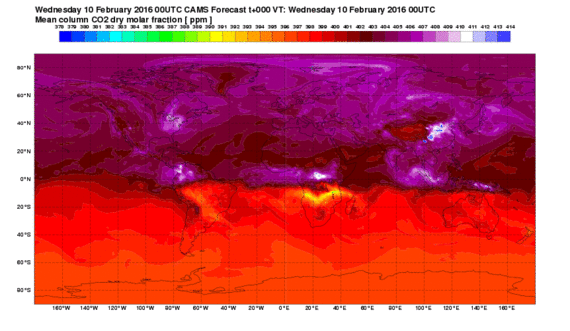- January 4, 2016
- in Green Tips
- by marcos
- 570
- 0

Extreme weather is all over the news, worldwide, this winter. Here in Britain we’ve just had one of the costliest run of floods the country has ever experienced, with economic losses of over $4.5Bn (PwC) and more expected. The Northeast US has been warm and wet with record breaking temperatures, whilst tornadoes and record breaking floods have gripped the Southeast. Then there is the heightened wildfire season in Australia, the persistent drought building up in Southern Africa and Ethiopia, and in Central America ongoing drought means 3.5 million people in Guatemala, Honduras and El Salvador are in need of food aid (WMO). These extremes are not just a coincidence.
Extremes, El Nino and climate change
Scientists have long warned that extreme events like these will become more common as a result of climate change leading to a warmer planet (e.g. IPCC extremes report). More heatwaves, record temperatures, a wetter planet overall and in general dry areas get drier and wet areas wetter. But the regional distribution of many of the extremes above also has the hallmarks of what climate scientists expect from the global footprint of a strong El Niño event. A natural phenomena characterised by the build-up of warm water in the tropical Pacific Ocean every 3-7 years that can influence climate and weather across the globe. It is therefore no surprise that this extreme weather is coinciding with the peaking of a super strength El Niño. Not just any El Niño, but the strongest El Niño event in the modern day record, beating the infamous 1997-98 “super” event. In many places this is heightening the changes in extremes we expect from climate change.
And it’s not just this winter. The current El Niño was already well established as a monster event in Summer 2015. The signature strong tropical cyclone season in the Central and Eastern Pacific and the somewhat suppressed Atlantic hurricane season, expected during an El Niño, both occurred. Models predicted then that the El Niño was very likely to hold and strengthen into this winter, like they normally do. Experts had a good idea what was coming.
What’s in store for 2016?
The current forecasts suggest this El Niño will stay strong through the spring (see here). The news is rightly all focused on record breakers and disasters, but on the upside, the benefits of a continuing strong El Niño persisting over the coming months include some likely reprieve, for example, to the massive long-term drought that has been gripping California for many years now. But it also suggests continued and worsened drought conditions are to be anticipated in many food-constrained regions of Africa and Central America, and a continuing wet season in the Southeast US and northern Europe ahead.
Forecasters expect 2016 to be the warmest year ever recorded. Models suggest this is primarily because of the long term warming trend caused by man-made climate change. But around 25% of the warming expected for 2016 is explained by the strong El Niño, which exacerbates the warming impact of climate change. In the case of the weather extremes, the 2015/2016 super El Niño in many regions either exacerbates or dampens the impacts driven by climate change.
What’s to blame?
Over the last decade the science of weather attribution has advanced. Huge progress in computing power has enabled finer scale resolutions to be modelled, with regional models better able to capture the smaller scales of weather extremes. Studies are proliferating with major extreme events, like those of this winter, now under autopsy almost in real time. The science is strongest for heatwaves and then droughts, and more challenging for flooding and storms, though in some cases still possible.
The World Weather Initiative is one such research program which today does real time analysis of high impact events to attribute likely cause – human-influence or other. They calculated that climate change made the December floods in the Northern UK from Storm Desmond 40% more likely (see here). The signal will be different, for the other extremes of this winter. Both climate change and/or the El Nino will be playing more of a role in some than others. But what is clear is that this new science of weather attribution has changed the narrative around weather disasters. In Summer 2007 when the UK was affected by flood losses of comparable magnitude, scientists steered away from making firm connections. The UK Met Office’s commentary on this winter’s UK floods brings climate change into sharper focus.
As weather attribution research progresses, this evidence will no doubt impact public policy, business and investment decisions, public perception, and could even potentially fuel climate court cases.
Some lessons for the future
1. Plan, build and invest for a changing risk horizon:
All the infrastructure we build and invest in today, including the $90Tr of infrastructure investment expected over the next 15 years, will need to function in a more extreme risk environment. Standard practice, from the insurance industry, to city planners, design and construction, investors, and policymakers, should be to not just plan for today’s 1/100 flood events, for example, but consider risk over the lifetime of assets concerned. For such a medium term view of risk to be mainstreamed, it will help for it to be rooted in policy and facilitated by industry regulators and ratings agencies. Better risk data, including data that takes into account climate change, should be a priority public sector and business investment, and needs to be widely accessible.
2. We have sophisticated forecasts, so use them, and invest in their next generation:
El Nino forecasts exist and are improving all the time. With an event as strong as the current one, experts have known for a while, at least since the summer, that such a winter of extremes was very likely, and where. The insurance industry, in many cases, already models the change in risk from certain climate perils correlated with El Niño. Underwriters are able to look at El Niño forecasts, stress test portfolios and factor this into their pricing. But this practice could be improved and mainstreamed within and beyond the sector. From Aid agencies and humanitarian relief organisations mobilising pre disaster, to public utilities, local authorities and businesses preparing resilience efforts.
3. Modernize our approach to climate risk management:
In our future world, we will need to get smarter quickly, in dealing with heightened weather extremes. Our traditional defences need to be reassessed and improved. New approaches to water management are key including reforestation and land reinstatement. Upgraded building codes with stricter monitoring and enforcement, and communication of residual risks to communities are vital.
The insurance industry will need to increasingly play a societal role. The sophisticated proprietary risk models this industry has could be used more widely by governments and business. Insurers will need to be in dialogue with governments. They will want to be involved in determining what gets built or rebuilt and where, in order for lifetime insurability to be achievable. They will also need to innovate new solutions to protect more people, such as risk pools, resilience bonds, and micro-insurance.
The huge progress over the last two decades in climate science and risk modelling means that we are getting smarter. The data, tools, experiences and evidence exists to prepare for a world of constant change, of changing risks, and of unprecedented extremes. Putting this into practice is sound climate risk management, which needs supportive institutional set up – from public investment and policies, to industry associations, regulators and rating agencies.
— This feed and its contents are the property of The Huffington Post, and use is subject to our terms. It may be used for personal consumption, but may not be distributed on a website.


